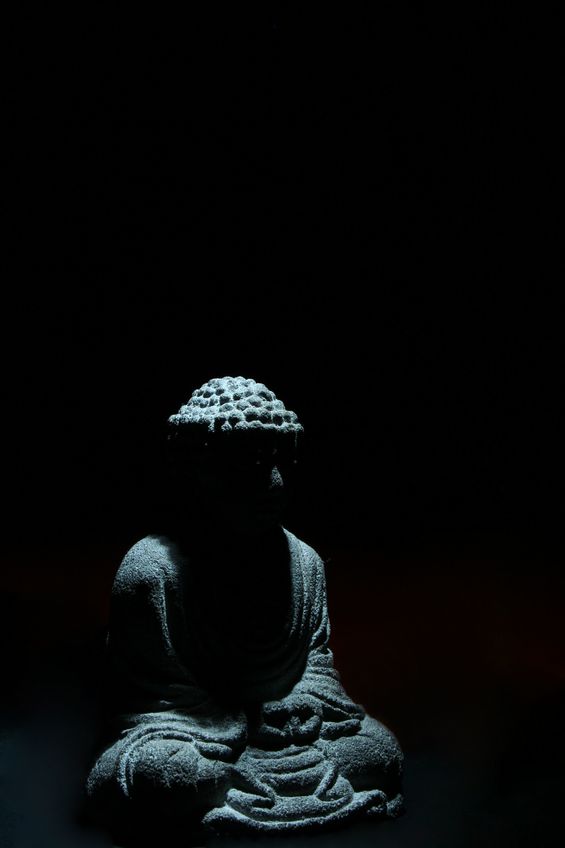Anxiety happens when you think you have to figure out everything all at once. Breathe. You’re strong. You got this. Take it day by day. ~Karen Salmansohn
Anxiety and stress seem to be everywhere today.
When they strike, each of us experiences a different reaction.
Some people push forward, strong in their resolve.
Others collapse inward, struggling to find enough air to take their next breath.
Negative emotions will always create negative outcomes if they are left to fester.
There must be an effort to relieve anxiety and stress. It will not just disappear on its own.
There are several different coping methods that can be used to help reduce the amount of stress and anxiety being experienced.
All of those coping methods can be captured into 7 general categories.
So pick your preferred category.
Then pick your preferred method to relieve stress and anxiety.
#1. Breathing

Breathing helps the body to be able to create a “relaxation response.”
This helps to reduce the overall cortisol levels [the stress hormone] that are active within your body.
The end result? Feeling relaxed. Feeling happier. Even perhaps feeling more energetic.
Here are some of the breathing exercises that have been proven to work for virtually everyone.
- Equal Breathing. Inhale to a 4 count, then exhale to a 4 count. Breathe all through your nose, so you can feel the resistance to your breathing. You can perform this breathing exercise at any place, during any time, whenever you feel a lack of calm throughout the day.
- Abdominal Breathing. Take a deep breath through the nose. Place your hand on your diaphragm to feel it inflate. Fill up your lungs with enough air that it feels slightly uncomfortable. The goal is to get your airways to stretch out just a bit. Take up to 10 slow, deep breaths per minute for about 10 minutes each day.
- Progressive Breathing. As you begin to take deep breaths, picture each muscle in your body beginning to relax progressively. Start at your toes and work your way up to your head. It can help to breathe in a count of 5 during this exercise to keep track of where you are in the muscle progression.
- Alternate Nostril Breathing. This is just like the equal breathing exercise, except that you close off one nostril for each breath intake or exhale. Close off the left nostril while breathing in, but then as you exhale, close off the right nostril.
- Happy Place Breathing. We all have a happy place that naturally relaxes us. It might be the beach, the bathroom, or even the car. Go there, get comfortable, and just breathe as deeply as you want. Picture favorite memories or find happy thoughts about something while you are in this moment.
- Kapalbhati. With this breathing exercise, the goal is to take a long, deep breath initially. Then you must exhale it powerfully and quickly. Your abdominal muscles are going to contract and the experience may not be comfortable the first few times you attempt this method to relieve anxiety and stress. When you do begin to get used to this technique, try to have an inhale/exhale combination occur every 2 seconds and repeat 10 times.
Even if you don’t feel like performing a specific breathing exercise, just being still and calm will help.
Gently breathe as you normally would, but within an environment that will not stimulate stress.
Count to 10 [or whatever number best suits your needs]. Then repeat as often as necessary.
When you are breathing, you are giving your body the oxygen it needs to expel toxins.
That process also helps to relax your muscles and reduce cortisol levels.
If you’re feeling stressed or are dealing with a tough bout with anxiety, then remember these two words: just breathe.
It will make all the difference in the world.
#2. Meditation

For the most part, fear is a negative emotion.
Sometimes we might need to flee from a situation. There might be an actual threat.
These are the only instances when fear is healthy.
Fear is what provides anxiety and stress with the structural support it needs to survive.
If you remove fear, then you’ll be able to reduce cortisol levels.
Meditation is often thought of as someone sitting in what is known as the “lotus” position.
That can be a very beneficial method, but there are several other forms of meditation that can be used as a way to relieve anxiety and stress.
- Open Monitoring Meditation. This form of meditation allows you to look at all aspects of your experience instead of a single point. Any perception, emotion, or sound is recognized, acknowledged, and reviewed for its unique importance. The goal here is to observe without reacting, which helps to lower stress.
- Effortless Presence Meditation. Instead of focusing on a single point, this form of meditation has you focus on nothing at all. You are simply “there” in that moment. Some might say this is the pursuit of clarity, but it is more about the process of meaning. Each moment has something to offer. Experience it effortlessly.
- Mindfulness Meditation. This type of meditation has you looking for the perfection that every moment offers. Like finding the sensory perfection in the things that we touch. Or in the smells of a home. Or in finding the good in those moments when a boss is yelling at your team. Because your focus is on finding the good and perfect moments in everything, stress and anxiety get the chance to disappear.
- Loving Kindness Meditation. This form of meditation is growing in popularity because it extends blessings outward. You spend time wishing those you know some form of a positive wish. In return, a loving inward attitude begins to develop. This allows you to be able to combat stress effectively because you’re turning negative emotions into positive outcomes.
- Mantra Meditation. Many forms of meditation include mantras, a repeated word or phrase, as part of the process. In Mantra meditation, the vibrations, rhythms, and sounds of the words or phrases become central to the overall experience. The goal here is to create a deeper connection to the mind, body, and soul by “feeling” the repetitions.
- Guided Meditation. It can be difficult to meditate alone sometimes. There can be a lot of distractions that take away your focus. That’s why having a guide to help you through the process can be extremely effective when dealing with high levels of anxiety and stress. Listen to the voice of the guide, follow any instructions given, and the negative feelings will begin to melt away.
Live and Dare offers you 17 more meditation options that can be beneficial in the quest to discover natural ways to reduce stress.
To succeed with meditation, the goal should be to meditate at least 20 minutes every day.
During the first days of a meditation routine, however, finding 20 minutes to set aside can be difficult.
Start with what you can do.
If you only meditate for 5 minutes, then you’ve taken 5 minutes to relieve stress. It will help.
Then build up from there.
#3. Music

The power of music is incredible. It can inspire. It can create emotion.
It can also reduce stress and anxiety very effectively.
Think about it: when you hear a favorite song, what happens?
Do you stay focused on the problems of the day?
Or do you start singing or humming along to the song?
There are several ways to relieve anxiety and stress through music.
Which methods would you prefer to use?
- Play an instrument. It isn’t necessary to master an instrument in order for the process of playing music to be beneficial. Something as simple as a scale on a piano can be enough to start reducing stress levels.
- Use your voice. Do you love to sing with the radio when you’re driving? When you’re doing that, you are actually reducing stress and anxiety at the same time. Just remember to sing songs that will uplift your spirit.
- Dance with music. The rhythms of certain types of music are almost like a verbal mantra. Just listening to them can help you be able to stay focused. If you dance with them as well, then you’ll be able to force stress and anxiety out of your body.
- Listen to music in known situations that are stressful. If your boss is about to give you some negative feedback at work, then put on some tunes so that you can mentally prepare yourself. Music in the background can also help you get through stressful tasks quickly and effectively. As an added benefit, listening to music in stressful situations also drowns out potentially distracting noises that could enhance a problematic situation.
- Brainwave entrainment. The mind will also tune itself to certain beats, tones, and rhythms to produce brainwaves in a certain pattern. This process allows you to experience the benefits of meditation, even if you happen to be working on something. Put on some headphones and the results will speak for themselves.
- Incorporate relaxing sounds into the music. Certain sounds help you to relax. Sounds like the falling rain, or gentle ocean waves, or even the traffic of the city. By incorporating these sounds into your music, you’ll be able to enhance the relaxation process.#
The American Psychological Association is even researching how music can be used as a medicine.
The right music can enhance a person’s sleep. It can slow a fast heart rate.
It will also have the power to reduce stress and anxiety effectively.
#4. EFT

The Emotional Freedom Techniques [EFT] is a type of therapy that uses nerve and pressure point tapping to help relieve stress and anxiety.
If you’re not familiar with the practice, then this complete guide to EFT can help provide some added understanding.
What makes EFT such a beneficial practice is that everyone can use it.
It is even safe to use with infants and toddlers.
This makes it one of the most versatile stress reducers that is available right now.
EFT has an advantage over other forms of stress reduction because it can help to relieve the symptoms of stress triggers that many people don’t often think about.
Could any of these issues be contributing to your stress or anxiety?
- Without exercise, the levels of dopamine, serotonin, and other hormones do not get produced at appropriate levels. Inactivity can also lead to a rise of free radicals that can promote bothersome signs and symptoms. EFT can help to promote an increase in the needed hormones.
- Sugar overload. Sugar acts like a drug on the brain. Eating too much of it can lead to poor mental health because the mind is literally over-stimulated. EFT can help to reduce that stimulation.
- Food additives. Food allergies are on the rise. Problems with food additives are also more common than ever before. Although EFT can’t make dietary changes for you, it can reduce the severity of the body’s reaction to these substances.
- Systemic inflammation. If you eat foods where there is an intolerance issue, then that toxicity can reach the brain over time. It dulls your thinking, creates ongoing fatigue, and stops creativity. EFT can help you restore some of the communication between the mind and body.
There are toxic exposure issues that are everywhere today.
Reactions vary in severity because we’re all a little different.
Some people can handle aspartame well, for example, and for others it can make them violently ill.
In total, there are 9 beneficial tapping spots that have been recognized by EFT.
Each one has the potential to provide effective stress relief.
You can do the tapping or you can have someone else do it for you.
As you are tapping, it is also beneficial to perform some deep breathing exercises.
Mantras, prayers, or other repetitive phrases have also been reported to be helpful by EFT users.
#5. Yoga

Yoga is often seen as an exercise regimen today in the Western World, but it is much more than that.
Sure – the stretching and poses offered in certain types of Yoga can be quite rigorous.
The spiritual side of Yoga can be equally rigorous.
This is because the ultimate goal of Yoga is to create harmony between the “me, myself, and I” of your existence: mind, body, and soul.
If you look at the history of Yoga, which dates back nearly 4,000 years, the idea of increasing personal knowledge while obtaining spiritual purification comes down to one question: what is the best way to relieve anxiety and stress in your personal life?
For that reason, there are several different Yoga practices that can be personally modified to maximize stress and anxiety reduction.
- Chakra Focus. There are 7 chakras, or centers, that are in your body. By focusing on just one of them, you can enhance the energy that is experienced at that chakra and then use it to reduce stress. Do so for 20-30 minutes or until you begin to feel uncomfortable.
- In traditional Yoga teachings, there is the belief that an “energy core” is located at the base of the spine. It lies dormant, waiting for you to activate it. Once activated, it is said that the amount of creative energy and enlightenment is beyond measure. It should only be practiced by an experienced individual or under guidance from someone who is.
- This practice is similar to focused meditation. You fix your gaze onto a single external object. Then you close your eyes, while still remaining focused on that object. The goal here is to work on the visualization powers of the mind. Because you are focused on this task, you become unfocused on your stress and anxiety. This helps it to just fade away.
- This type of Yoga focuses on external or internal sounds. Many who first start with this type of Yoga will use ambient music, nature sounds [like ocean waves or falling rain], or even classical music from Bach or Beethoven. As personal skills develop to hear different layers of sounds, the individual is encouraged to listen for internal sounds. Then the ultimate goal is to hear para nada, or the one sound of life that has no vibration.
- This form of Yoga might be popular because of its sexual connotations, but there are actually hundreds of different tantras that can be practiced. You can focus on the space between two thoughts, meditate on a specific emotion, or virtually anything else that holds importance to you. When you focus on the larger picture, but in the smallest of details, the triggers for stress and anxiety just don’t seem as important as they once did.
The benefit of Yoga is that it combines aspects of meditation, exercise, and deep breathing all in one session.
This trinity of stress reduction is incredibly effective, with results often coming in just a few days.
Some may need to remove their preconceived notions about Yoga.
It will not interfere with any religion, career, or relationship.
Others may simply need to make it a priority in their life.
We all make time for the things that are a top priority for each of us.
If you can make Yoga a top priority, then you will know how to handle stress better.
#6. Exercise

If you’re dealing with high levels of stress and anxiety, then a little exercise might just be the solution you need.
We all have heard multiple times about the physical benefits of exercise.
It makes you stronger, faster, and improves stamina.
It also has the power to fight off disease.
This is why almost every doctor will encourage physical activities every day, whenever possible.
Exercise is also beneficial for mental fitness. It will reduce fatigue, improve concentration, and even enhance cognitive functions.
When stress has caused your energy levels to be prematurely depleted, just 5 minutes of aerobic exercise can help to restore what you’ve lost.
Every type of exercise is beneficial in some way.
Here are the best exercises that are commonly used to relieve anxiety and stress.
Choose the one that you feel like you can do the best.
- Walking, running, or jogging. The goal here is to do the most comfortable exercise out of this trifecta for at least 30 minutes. Set the goal to complete a minimum of 3 exercises sessions per week, with the eventual goal of walking, running, or jogging 5 times per week.
- Biking or dancing. People who use these types of exercise for stress relief tend to pack them into long weekend sessions. It’s better to bike or dance 20-30 minutes every day than to put in 3-4 hours of exercise during the weekend.
- If you focus on the physical forms of Yoga only, the core strengthening and stretching components of practice, along with the added breathing, has been proven to calm down the mind.
- Taking a trail through the woods or up a mountain is a little different than walking or jogging around a neighborhood or on a treadmill. Not only does nature have a calming effect on the mind, but you’ll also be giving yourself a more strenuous exercise regimen. Walking up a 20 to 45-degree slope is a lot different than walking on a flat sidewalk and the amount of stress reduction corresponds to the increased activity levels.
- Strength training. Lifting weights can also take the place of aerobic exercise for some individuals. 30-45 minutes of weight training can stimulate a person’s metabolism for up to 48 hours afterward. While the metabolism is stimulated, the body has more natural tools to help you combat stress and anxiety.
Exercise can be a very effective tool to help you be able to find your center once again.
Not only will the exercise help you be able to reduce overall mental fatigue, but you’ll receive a natural energy boost and get more sleep at night.
More sleep at night means more power to combat future stress and anxiety.
This means exercise can create a positive cycle of health that can help you keep cortisol levels naturally low on a regular basis.
#7. Conversation

Talking to someone can be very beneficial when feeling high levels of stress or anxiety.
The conversation should be with someone you trust: a friend, family member, or close associate.
It must be a non-judgmental environment so you can express the emotions of stress and anxiety properly.
There must also be a willingness to provide you with feedback after you’ve finished discussing your concerns.
Following these steps can help you to make sure that the conversation you have will be able to be beneficial.
- Isolate the conversation. You don’t need to be speaking with someone you trust in front of an audience. Go behind closed doors. Go get coffee somewhere that is outside of your routine. Even a quiet corner of a park can be a great location.
- Express your concerns. Be as specific as possible. Why are you feeling stressed out? What is making you feel anxious? Do your best to put these negative thoughts into positive words.
- Summarize your feelings. Stress and anxiety often involve fear. There might also be other emotions involved. Make sure every potentially negative emotion is addressed so it isn’t left to fester and grow on its own.
- Connect your feelings to your choices. How we feel is often reflected in the choices we make. Do your best to connect the feelings you are having to the choices you’ve been making.
- Assess yourself. As you are talking, is it making you feel better? Or are you feeling worse? If a conversation is causing your stress and anxiety to increase, then you should stop immediately and use a different stress reduction method.
- Prepare yourself for the drop. Your body does not handle high levels of cortisol very well. It amps itself up to deal with the stress. When you are able to let that stress go, then there will be a physical feeling of release. Many people feel fatigued or exhausted after the release occurs. Be prepared for this so you don’t potentially put yourself into a dangerous situation – like being behind the wheel of a car.
- Enter into new territory. You must then make the choice to leave those negative feelings behind. You’ve expressed them in a conversation. You’ve now developed a solution. It’s time to let the anxiety and stress go. Retaining it will only cause it to continue to grow.
If you’ve followed these steps, then you may have noticed that the steps spell out something unique: I Escape.
You can escape from your stress and anxiety.
The only issue is that it must be something that you’re willing to do.
No one can take the footsteps forward on your journey toward a more peaceful existence.
It must come from you. The effort must come from inside you.
Now a trusted friend, family member, or associate can give you meaningful advice during this conversation so that it becomes easier to take those steps.
But in the end, it will be up to you. It will always be up to you.
Sometimes we get so comfortable in dealing with stress and anxiety on a regular basis that we just allow these negative expressions to exist.
There is a better way. Talk it out.
Which Ways to Relieve Anxiety and Stress Are Right for You?
There are 7 primary categories of coping skills available to you right now.
Each one has the potential of reliving anxiety and stress very effectively.
Within each category are specific methods that can be used to make sure you can relax and rejuvenate, even after the most stressful day of your life.
Many of these methods can be combined with others to create a comprehensive treatment plan to combat stress and anxiety.
You could combine music, Yoga, and deep breathing.
Maybe exercise, EFT, and meditation would be a better combination for you.
The fact is this: there is no single relaxation or stress removal technique that is the best one for everyone.
It is up to you to implement a plan that works, which often involves a great deal of trial and error during the first days of dealing with stress.
If you persevere, you will find that you will know how to handle stress better.
The natural ways to reduce stress can be used with a doctor-supervised treatment plan or on your own.
With continued effort, there will be continued results.
What are the ways that you use to relieve stress and anxiety? Have you implemented one or more of the methods included above?
—————————————————————-
Ganna Tugolukova © 123RF.com, bluedarkat © 123RF.com, ynamaku © 123RF.com, citalliance © 123RF.com, Monika Wisniewska © 123RF.com, dimaberkut © 123RF.com, lzflzf © 123RF.com, Vadim Gnidash © 123RF.com


